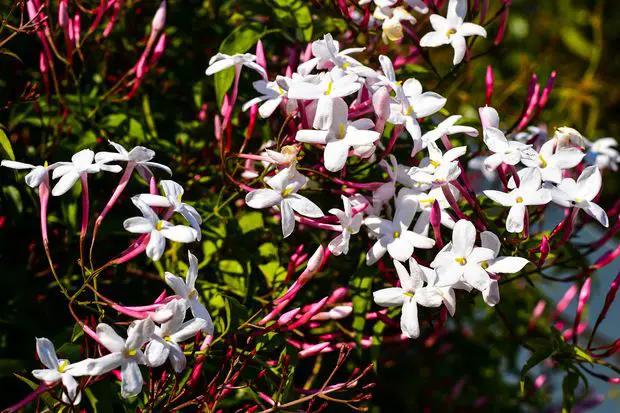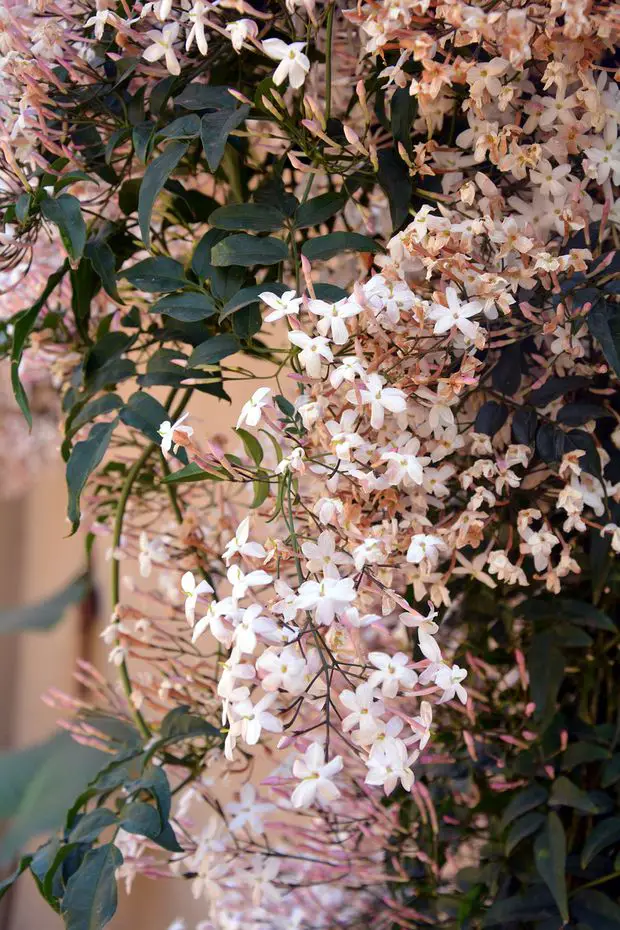Pink Jasmine or Jasminum Polyanthum is one of the most beautiful Jasmine species there is, belonging to the family of Oleaceae. Pink jasmine is a climbing Jasmine variety commonly found in recreational areas, garden decoration and indoors house ornaments, as it is one of the easiest species to care for ( not as dedicated or sensitive to maintain vibrant and alive in comparison to other species of jasmine such as the Madagascan Jasmine plant) and usually, looking fabulous through out the year.

It is super popular around gardens and backyards, not only because of the appearance of its beautiful velvety white to pink flower, but also because of the absolutely sweetly scented flowers.
Altogether, this Jasmine variety, has captivated the attention of humans, not only as an element of visual enjoyment but also, as part of a decadent cuisine and luxury cosmetics.

Is Jasminum Polyanthum edible?
This is a question that is is commonly asked: Is Jasminum Polyanthum poisonous to humans? The answer is no, it is not toxic to humans. Pink Jasmine flowers are edible and non-toxic to humans, as they don’t really contain in high amounts any chemical harmful for human wellbeing, whilst being ingested or digested.
Pink Jasmine plants/flowers have become popular in foods and especially in high cuisine by being part of exquisite salads and enriching scented teas.
Originally, from the ancient cuisine and medicinal use in India and China, Pink jasmine has been used to treat all sorts of issues such as depression, headaches and muscle soreness. Especially, the oils for its fragrance, have been used for ages as a muscle relaxant and later in time in the form of drinkable tea.
From ancient times, traditional medicine has shown its health benefits in regulating energy balances, providing some boost, regulating insulin spikes, skin soothing benefits, alleviating headaches and muscle soreness and perhaps displaying some anti tumour features.
This is not random information, this is due to the fact that Pink Jasmine (and also some other Jasmine varieties) contain a chemical, called indoles.
Indoles and derivatives are alkaloid compounds involved in many physiological processes, such as, muscle contraction and phosphorylation of tryptophan, an essential amino acid involved in many biological processes. They are also very present in the new synthesis drugs, such as, refined chemotherapies and other pharmacological compounds.
Pink Jasmine or Jasminum Polyanthum is favourite of the South African gardens and it is commonly used to make scented tea by crushing and drying its beautiful pink buds and start-shaped flowers.
To make this unique scented tea, simply harvest the waxy textured flowers in the early morning, when the flowers are closed up. Then, carefully cut the stems that contain the highest amount of flowers buds. Try not to harm the flower petals, as this will subtract from the fragrance in the end tea product.
Accumulate those flowers in a jar and let them dry out for about 6 weeks and then use them and its leaves to boil some water and fragrant your tea.
There are numerous recipes on how to use pink jasmine flowers in the form of food or tea or even high end cocktails such as pink jasmine tea infused vodka!

Is Jasminum Polyanthum poisonous to animals?
Pink jasmine is also known to be non-toxic to dogs, cats and horses according to the American Society for the Prevention of Cruelty to Animals. Having said that, you might have to keep an eye for your pet, if it has ingested some of these jasmine flowers or leaves as it might be difficult to digest for not being part of the usual, typical diet, they might experience some gastro intestinal tract distress, resembling poisoning features. These might include some loss of appetite, diarrhea and regurgitation. Animals, such as, cats and dogs, don’t usually ingest flowers as part of their normal diet, but they might feel adventurous or purge themselves if out in the garden or park and experience some allergy or sensitivity to these jasmine flowers. If you know or have observed your peat eat some of that pink jasmine, pay close attention for any of these symptoms to manifest.
The ‘go-to’ protocol for pet poisoning responses, is to remove all the flowers or leaves, in this case, pink jasmine flowers, from the surroundings of its reach, as well as, its mouth and rinse it throughly and heavily with cold fresh water. Watch your pet for any of those above stated symptoms (including foaming through the mouth or paw swelling) and if any evidences then, call the vet immediately. Do not try to induce their vomiting, as the acid of their stomach can worsen the situation.
Wrapping it up! Pink Jasmine is an edible Jasmine variety, non-toxic to humans and animals, with a an excellent value, not only in traditional medicine, because of its multiple health benefits, but also, in refined cuisine, particularly in the form of tea, and luxurious cosmetics, being part of the most exquisite perfumes and oils.
